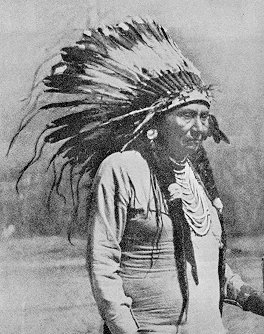Chief Joseph - History
The Nez Perce Treaty of 1855 reserved vast areas of land for the Nez Perce Indian Tribe. The land stretched from what is now central Idaho to the eastern edges of both Washington and Oregon. Tucked remotely away in the Oregon allotment was the beautiful and fertile Wallowa Valley Here, among the picturesque setting and the superior hunting grounds, Chief Tu-eka-kas (Chief Joseph's father) and his band of Nez Perce lived peacefully For unnumbered generations the Wallowa Valley had been the home of their ancestors.
Hostilities began when settlers and cattlemen increasingly trespassed upon the Indian's land. In 1861, when gold was discovered in Orofino, Idaho, 10,000 miners invaded their home land in search of the precious mineral. The friendly Indians became restless.
In 1863, the U.S. Government offered a new treaty in an attempt to pacify the new settlers and give unobstructed access to the
newly discovered mines. Chief Tu-eka-kas refused to sign the treaty because it totally excluded the Wallowa Valley and
outlying areas from the Indian's land. However, a number of Chiefs whose interests were not affected, signed the new treaty
and the Government contended that all the Nez Perce were bound. Tu-eka-kas and his tribe were to leave the Wallowa Valley
and move to the newly designated Lapwai reservation in Idaho.
attempt to pacify the new settlers and give unobstructed access to the
newly discovered mines. Chief Tu-eka-kas refused to sign the treaty because it totally excluded the Wallowa Valley and
outlying areas from the Indian's land. However, a number of Chiefs whose interests were not affected, signed the new treaty
and the Government contended that all the Nez Perce were bound. Tu-eka-kas and his tribe were to leave the Wallowa Valley
and move to the newly designated Lapwai reservation in Idaho.
Tu-eka-kas ignored the treaty and despite grievances against the Government, skillfully maintained peace with the settlers. He
and his people remained in the Wallowa Valley until his death.
With Tu-eka-kas now in his grave, the mantle of authority fell upon Joseph (Eagle Wing or Hallakallakeen) His young braves were held in check in spite of the
growing resentment felt at losing more land and horses to an increasing white population. The Government continued to urge
Joseph to give up the land peacefully and move his people to the reservation.
Finally in the spring of 1877, General Howard of the United States Army became impatient and notified Chief Joseph that he
must move within 30 days or be driven out by soldiers. Joseph, realizing the unfavorable odds of a fight with the U.S. Army
reluctantly agreed to move.
The disappointed tribe dismantled their Wallowa Valley camp for the last time in late May of 1877, moving off toward the
Snake River. Chief Joseph's band consisted of approximately 400 Indians, including about 64 braves, ages 16 and over. They
took over 1,000 head of horses and cattle, leaving much of their stock behind. The Nee-Me-Poo National Recreation Trail
was the route followed to the Snake River.
After crossing the Snake River, Joseph's people joined with other bands of Nez Perce and a small group of Palouses.
Thereafter, the historical Nez Perce War began, turning the peaceful journey into a flight for freedom and sanctuary in Canada.
Every mile of the retreat brought danger Aided by Chief Joseph's surpassing military genius, the Nez Perce confused and
outwitted the 2,000 regular troops of the United States Army Though the warriors were encumbered with women, children and
the elderly throughout their flight, they were able to outdistance the fresh troops continually appearing in their path.
Joseph and his people came to the end of their bloody trail in the Bear Paw Mountains of Montana, only 48 km (30 miles) from
the Canadian refuge. Hemmed in by winter snow the Indians were besieged by the U.S. Army and forced to surrender After
three months of unquestionable grief, anxiety and hardship, Joseph, in a pathetic, yet dramatic surrender, said "From where the
sun now shines, I shall fight no more forever."
Thanks to Paul Keller pkeller@tricity.wsu.edu for having this on the net for me to borrow.
BACK
 attempt to pacify the new settlers and give unobstructed access to the
newly discovered mines. Chief Tu-eka-kas refused to sign the treaty because it totally excluded the Wallowa Valley and
outlying areas from the Indian's land. However, a number of Chiefs whose interests were not affected, signed the new treaty
and the Government contended that all the Nez Perce were bound. Tu-eka-kas and his tribe were to leave the Wallowa Valley
and move to the newly designated Lapwai reservation in Idaho.
attempt to pacify the new settlers and give unobstructed access to the
newly discovered mines. Chief Tu-eka-kas refused to sign the treaty because it totally excluded the Wallowa Valley and
outlying areas from the Indian's land. However, a number of Chiefs whose interests were not affected, signed the new treaty
and the Government contended that all the Nez Perce were bound. Tu-eka-kas and his tribe were to leave the Wallowa Valley
and move to the newly designated Lapwai reservation in Idaho.